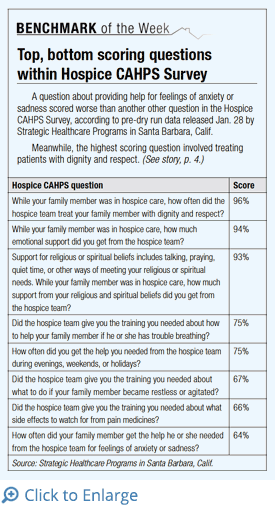Republished with permission from Decision Health. Article originally published on Home Health Line February 15, 2015.
Make sure your hospice’s social workers and chaplains properly train nurses about how to recognize and treat anxiety and sadness in patients who refuse the help of social workers or chaplains.
There is sometimes a stigma about the services social workers and chaplains provide, and as a result some hospice patients refuse to receive their care, says Katie Wehri, hospice operations expert for the National Association for Home Care & Hospice.
Although hospice nurses should be asking questions to identify whether their patients are anxious or sad, not all nurses have expertise to recognize and treat anxiety issues — nor do they always have the time and tools available to teach things such as relaxation techniques or time management, Wehri says. Developing scripts to explain social work and chaplain services in such a way that minimizes or overcomes the stigma and resistance to these services will increase the number of patients these team members can work with on anxiety and stress issues.
Survey vendor Strategic Healthcare Programs (SHP) on Jan. 28 released an early look at Hospice Consumer Assessment of Healthcare Providers and Systems (CAHPS) Survey questions with the highest and lowest scores. That data will be useful as hospices work to improve as soon as possible in areas measured by the survey, which launches April 1.
SHP’s information comes from about 1,100 hospice surveys it conducted from Sept. 14, 2014 to Jan. 19, 2015. The data show hospices require improvement in several areas, including training families about what to do if patients become restless or agitated.
The lowest scoring question on the 47-question survey, which drew a 64% response, asks, “How often did your family member get the help he or she needed from the hospice team for feelings of anxiety or sadness?”
It’s possible that in some circumstances, family members responding with low marks believed that assistance was given — but not often enough, notes Barbara Rosenblum, SHP’s founder and CEO.
Providing better training and tools for nurses — and providing them additional time with patients to address anxiety issues — may help improve hospices’ scores on the question, Wehri adds.
While SHP’s initial survey data doesn’t fully conform to CMS’ sampling methodology, “these raw scores offer an unprecedented first glimpse at where hospices are struggling and succeeding,” according to the Barbara, Calif.-based company. (See benchmark image).
How does the dry run work?
Many hospices have taken significant strides to prepare for the survey (HHL 1/19/15). But those that haven’t must hire a CMS-approved survey vendor quickly and participate in at least one month of a dry run during the first quarter of 2015.
The January 2015 sample includes patients who died between Jan. 1 and Jan. 31.
Data collection for sampled decedents and caregivers must be initiated two months after the month of patient death, CMS says. For example, vendors for hospices participating in the January dry run will begin surveying sampled decedents and caregivers as of April 1. Vendors for hospices participating in the March dry run, meanwhile, will begin surveying sampled decedents and caregivers as of June 1.
Participating in a dry run involving January deaths will give hospices extra time to address issues, SHP believes.
Tips to relieve anxiety, sadness
Hospices can do several things to reduce patients’ feelings of anxiety or sadness.
- Spread out visits so nurses, social workers and/or chaplains aren’t meeting with patients on the same day. At many hospices, a nurse visits the patient once or twice a week, while a social worker and a chaplain visit the patient once a month, says Ruth Recchia, Pleasant Valley, N.Y-based senior manager at Simione Healthcare Consultants.
By spacing patient appointments out, the patient or family member feels a bit more support from the hospice than if, for instance, a chaplain and social worker are scheduled to perform their one monthly visit on the same day, Recchia says. - Make sure you’re asking patients during every visit if they’re feeling anxious today. Chaplains and social workers are good at doing this, Recchia says, but some nurses do not always ask the patient questions such as: “How are you feeling today? Are you in pain? Are you feeling anxious today?”
Understand that while many patients are reluctant to take anti-anxiety medication, they might need it at this point in their lives. The patient’s nurse should discuss patient anxiety, during certain instances, with the physician and get an order for anti-anxiety medication, Recchia says.
— Josh Poltilove (jpoltilove@decisionhealth.com)


